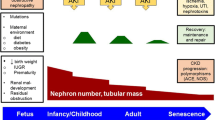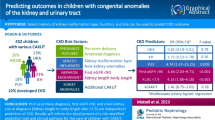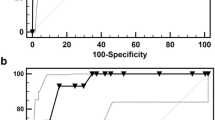Abstract
Congenital lower urinary tract obstruction is associated with oligohydramnios and significant perinatal mortality and long-term chronic kidney disease. The counseling of families facing this diagnosis, especially when prenatal intervention is proposed, is fraught with ambiguity. This review aims to equip the provider with the current evidence behind the conventional and novel biomarkers predictive of chronic kidney disease. The relevant clinical predictors are categorized by when they are identified, antenatally or postnatally, and as either anatomic or chemical. They are considered for their prognostic value and the challenges in obtaining them, specifically the risk to the fetus in the case of prenatal biomarkers. Serum creatinine in infancy is the traditional chemical biomarker of kidney function and continues to be a consistent predictor of future serum creatinine. β-2 microglobulin may provide earlier information regarding fetal glomerular and tubular function and is also predictive of long-term serum creatinine. Renal parenchymal area is an anatomic surrogate of nephron mass that is used in both prenatal and postnatal settings. Understanding the anatomic and chemical biomarkers is essential for future refinement of the staging algorithm used to distinguish which patients may benefit from early in utero intervention.


Similar content being viewed by others
References
Malin G, Tonks AM, Morris RK, Gardosi J, Kilby MD (2012) Congenital lower urinary tract obstruction: a population-based epidemiological study. BJOG 119:1455–11464
Neild GH (2009) What do we know about chronic renal failure in young adults? II. Adult outcome of pediatric renal disease. Pediatr Nephrol 24:1921–1928
Thakkar D, Deshpande AV, Kennedy SE (2014) Epidemiology and demography of recently diagnosed cases of posterior urethral valves. Pediatr Res 76:560–563
Morris RK, Tonks A, Kilby MD (2011) Fetal lower urinary tract obstruction: an epidemiological, population based study of outcome. Reprod Sci 18:366A
Sarhan OM (2017) Posterior urethral valves: impact of low birth weight and preterm delivery on the final renal outcome. Arab J Urol 15:159–165
Puttmann KT, White JT, Huang GO, Sheth K, Elizondo R, Zhu H, Braun MC, Mann DG, Olutoye OA, Tu DD, Ruano R, Belfort M, Brandt ML, Roth DR, Koh CJ (2019) Surgical interventions and anesthesia in the 1st year of life for lower urinary tract obstruction. J Pediatr Surg 54:820–824
Parkhouse HF, Barratt TM, Dillon MJ, Duffy PG, Fay J, Ransley PG, Woodhouse CR, Williams DI (1988) Long-term outcome of boys with posterior urethral valves. Br J Urol 62:59–62
Kousidis G, Thomas DFM, Morgan H, Haider N, Subramaniam R, Feather S (2008) The long-term outcome of prenatally detected posterior urethral valves: a 10 to 23-year follow-up study. BJU Int 102:1020–1024
Vasconcelos MA, Simoes e Silva AC, Gomes IR, Carvalho RA, Pinheiro SV, Colosimo EA, Yorgin P, Mak RH, Oliveira EA (2019) A clinical predictive model of chronic kidney disease in children with posterior urethral valves. Pediatr Nephrol 34:283–294
Morris RK, Kilby MD (2011) Long-term renal and neurodevelopmental outcome in infants with LUTO, with and without fetal intervention. Early Hum Dev 87:607–610
Dias T, Sairam S, Kumarasiri S (2014) Ultrasound diagnosis of fetal renal abnormalities. Best Pract Res Clin Obstet Gynaecol 28:403–415
Deshpande AV (2018) Current strategies to predict and manage sequelae of posterior urethral valves in children. Pediatr Nephrol 33:1651–1661
Sepulveda W (2004) Megacystis in the first trimester. Prenat Diagn 24:144–149
Fontanella F, Duin LK, Adama van Scheltema PN, Cohen-Overbeek TE, Pajkrt E, Bekker M, Willekes C, Bax CJ, Gracchi V, Oepkes D, Bilardo CM (2018) Prenatal diagnosis of LUTO: improving diagnostic accuracy. Ultrasound Obstet Gynecol 52:739–743
Al-Hazmi H, Dreux S, Delezoide AL, Dommergues M, Lortat-Jacob S, Oury JF, El-Ghoneimi A, Muller F (2012) Outcome of prenatally detected bilateral higher urinary tract obstruction or megacystis: sex-related study on a series of 709 cases. Prenat Diagn 32:649–654
Quintero RA (2005) Fetal obstructive uropathy. Clin Obstet Gynecol 48:923–941
Williams CR, Perez LM, Joseph DB (2001) Accuracy of renal-bladder ultrasonography as a screening method to suggest posterior urethral valves. J Urol 165:2245–2247
Montemarano H, Bulas DI, Rushton HG, Selby D (1998) Bladder distention and pyelectasis in the male fetus: causes, comparisons, and contrasts. J Ultrasound Med 17:743–749
Bernardes LS, Aksnes G, Saada J, Masse V, Elie C, Dumez Y, Lortat-Jacob SL, Benachi A (2009) Keyhole sign: how specific is it for the diagnosis of posterior urethral valves? Ultrasound Obstet Gynecol 34:419–423
Laudy JAM, Wladimiroff JW (2000) The fetal lung 1: developmental aspects. Ultrasound Obstet Gynecol 16:284–290
Fontanella F, Adama van Scheltema PN, Duin L, Cohen-Overbeek TE, Pajkrt E, Bekker MN, Willekes C, Oepdes D, Bilardo CM (2018) Antenatal staging of congenital lower urinary tract obstruction. Ultrasound Obstet Gynecol
Morris RK, Malin GL, Khan KS, Kilby MD (2009) Antenatal ultrasound to predict postnatal renal function in congenital lower urinary tract obstruction: systematic review of test accuracy. BJOG 116:1290–1299
Johnson MP, Danzer E, Koh J, Polzin W, Harman C, O’Shaughnessy R, Brown R, Zaretsky MV (2018) North American Fetal Therapy Network (NAFTNet). Fetal Diagn Ther 44:10–17
Van Calster B, Wynants L, Verbeek JFM, Verbakel JY, Christodoulou E, Vickers AJ, Roobol MJ, Steyerberg EW (2018) Reporting and interpreting decision curve analysis: a guide for investigators. Eur Urol 74:796–804
Harper L, Waubant A, Vigries J, Amat S, Dobremez E, Lefevre Y, Ferdynus C (2017) Can quantity of amniotic fluid reliably predict postnatal renal function in boys with posterior urethral valves: a decision curve analysis. Prenat Diagn 37:931–934
Bornes M, Spaggiari E, Schmitz T, Dreux S, Czerkiewicz I, Delezoide AL, El-Ghoneimi A, Oury JF, Muller F (2013) Outcome and etiologies of fetal megacystis according to gestational age at diagnosis. Prenat Diagn 33:1162–1166
Matsell DG, Yu S, Morrison SJ (2016) Antenatal determinants of long-term kidney outcome in boys with posterior urethral valves. Fetal Diagn Ther 39:214–221
Faure A, Panait N, Panuel M, Alessandrini P, D’Ercole C, Chaumoitre K, Merrot T (2017) Predicting postnatal renal function of prenatally detected posterior urethral valves using fetal diffusion-weighted magnetic resonance imaging with apparent diffusion coefficient determination. Prenat Diagn 37:666–672
Moscardi PRM, Katsoufis CP, Jahromi M, Blachman-Braun R, DeFreitas MJ, Kozakowski K, Castellan M, Labbie A, Gosalbez R, Alam A (2018) Prenatal renal parenchymal area as a predictor of early end-stage renal disease in children with vesicoamniotic shunting for lower urinary tract obstruction. J Pediatr Urol 14:320.e1–320.e6
Biard J-M, Johnson MP, Carr MC, Wilson RD, Hedrick HL, Pavlock C, Adzick NS (2005) Long-term outcomes in children treated by prenatal vesicoamniotic shunting for lower urinary tract obstruction. Obstet Gynecol 106:503–508
Morris RK, Quinlan-Jones E, Kilby MD, Khan KS (2007) Systematic review of accuracy of fetal urine analysis to predict poor postnatal renal function in cases of congenital urinary tract obstruction. Prenat Diagn 27:900–911
Abdhennadher W, Chalouhi G, Dreux S, Rosenblatt J, Favre R, Guimiot F, Salomon LJ, Oury JF, Ville Y, Muller F (2015) Fetal urine biochemistry at 13-23 weeks of gestation in lower urinary tract obstruction: criteria for in-utero treatment. Ultrasound Obstet Gynecol 46:306–311
Dreux S, Rosenblatt J, Moussy-Durandy A, Patin F, Favr R, Lortat-Jacob S, El Ghoneimi A, Oury JF, Deschenes G, Ville Y, Heidet L, Muller F (2018) Urine biochemistry to predict long-term outcomes in fetuses with posterior urethral valves. Prenat Diagn
Klein J, Lacroix C, Caubet C, Siwy J, Zurbig P, Dakna M, Muller F, Breuil B, Stalmach A, Mullen W, Mischak H, Bandin F, Monsarrat B, Bascands JL, Decramer S, Schanstra JP (2013) Fetal urinary peptides to predict postnatal outcome of renal disease in fetuses with posterior urethral valves. Sci Transl Med 5:198ra106
Johnson MP, Corsi P, Bradfield W, Hume RF, Smith C, Flake AW, Qureshi F, Evans MI (1995) Sequential urinalysis improves evaluation of fetal renal function in obstructive uropathy. Am J Obstet Gynecol 173:59–65
Luton D, Delezoide AL, Leguy MC, Gobeaux C, Vuillard E, Grange G, Guibourdenche J (2013) Foetal serum but not urinary β2-microglobulin correlates with histological injury to the kidney. Clin Biochem 46:1607–1610
Vieira ELM, Pessoa Rocha N, Macedo Bastos F, da Silveira KD, Pereira AK, Araujo Oliveira E, Marques de Miranda D, Simoes E, Silva AC (2017) Posterior urethral valve in fetuses: evidence for the role of inflammatory molecules. Pediatr Nephrol 32:1391–1400
Chevalier RL (2004) Biomarkers of congenital obstructive nephropathy: past, present and future. J Urol 172:852–857
Rocha NP, Bastos FM, Vieira ELM, Prestes TRR, Silveira KDD, Teixeira MM, Simoes E Silva AC (2018) The protective arm of the reninangiotensin system may counteract the intense inflammatory process in fetuses with posterior urethral valves. J Pediatr (Rio J) 2018 Mar 11
Spaggiari E, Faure G, Dreux S, Czerkiewicz I, Stirnemann JJ, Guimiot F, Heidet L, Favre R, Salomon LJ, Oury JF, Ville Y, Muller F (2017) Sequential fetal serum β2-microglobulin to predict postnatal renal function in bilateral or low urinary tract obstruction. Ultrasound Obstet Gynecol 49:617–622
Dommergues M, Muller F, Ngo S, Hohlfeld P, Oury JF, Bidat L, Mahieu-Caputo D, Sagot P, Body G, Favre R, Dumez Y (2000) Fetal serum beta2-microglobulin predicts postnatal renal function in bilateral uropathies. Kidney Int 58:312–316
Spaggiari E, Stirnemann JJ, Benedetti S, Dreux S, Salomon LJ, Blanc T, Rosenblatt J, Favre R, Ville Y, Muller F (2018) Comparison of biochemical analysis of fetal serum and fetal urine in the prediction of postnatal renal outcome in lower urinary tract obstruction. Prenat Diagn 38:555–560
Vasconcelos MA, Simoes E Silva AC, Dias CS, Gomes IR, Carvalho RA, Figueiredo SV, Dumont TR, Oliveira MCL, Pinheiro SV, Mak RH, Oliveira EA (2019) Posterior urethral valves: comparison of clinical outcomes between postnatal and antenatal cohorts. J Pediatr Urol 15:167
Hochart V, Lahoche A, Priso RH, Houfflin-Debarge V, Bassil A, Sharma D, Behal H, Avni FE (2016) Posterior urethral valves: are neonatal imaging findings predictive of renal function during early childhood? Pediatr Radiol 46:1418–1423
Odeh R, Noone D, Bowlin PR, Braga LHP, Lorenzo AJ (2016) Predicting risk of chronic kidney disease in infants and young children at diagnosis of posterior urethral valves: initial ultrasound kidney characteristics and validation of parenchymal area as forecasters of renal reserve. J Urol 196:862–868
Schneider CA, Rasband WS, Eliceiri KW (2012) NIH Image to ImageJ: 25 years of image analysis. Nat Methods 9:671–675
Cost GA, Merguerian PA, Cheerasarn SP, Shortliffe LM (1996) Sonographic renal parenchymal and pelvicaliceal areas: new quantitative parameters for renal sonographic followup. J Urol 156:725–729
Wong IY, Copp HL, Clark CJ, Wu HY, Shortliffe LD (2009) Quantitative ultrasound renal parenchymal area correlates with renal volume and identifies reflux nephropathy. J Urol 182(4 Suppl):1683–1687
Pulido JE, Furth SL, Zderic SA, Canning DA, Tasian GE (2014) Renal parenchymal area and risk of ESRD in boys with posterior urethral valves. Clin J Am Soc Nephrol 9:499–505
den Bakker E, Gemke RJBJ, Bokenkamp A (2018) Endogenous markers for kidney function in children: a review. Crit Rev Clin Lab Sci 55:163–183
Denes ED, Barthold JS, Gonzalez R (1997) Early prognostic value of serum creatinine levels in children with posterior urethral valves. J Urol 157:1441–1443
Lemmens AS, Mekahli D, Devlieger R, Levtchenko E, Allegaert K (2015) Population-specific serum creatinine centiles in neonates with posterior urethral valves already predict long-term renal outcome. J Matern Fetal Neonatal Med 28:1026–1031
Coleman R, King T, Nicoara CD, Bader M, McCarthy L, Chandran H, Parashar K (2015) Nadir creatinine in posterior urethral valves: how high is low enough? J Pediatr Urol 11:356.e1–356.e5
Coleman R, King T, Nicoara CD, Bader M, McCarthy L, Chandran H, Parashar K (2015) Combined creatinine velocity and nadir creatinine: a reliable predictor of renal outcome in neonatally diagnosed posterior urethral valves. J Pediatr Urol 11:214.e1–214.e3
Sharma RK, Sharma AP, Kapoor R, Gupta A (2001) Prognostic significance of distal renal tubular acidosis in posterior urethral valve. Pediatr Nephrol 16:581–585
McLeod DJ, Ching CB, Sebastiao YV, Greenberg JH, Furth SL, McHugh KM, Becknell B (2019) Common clinical markers predict end-stage renal disease in children with obstructive uropathy. Pediatr Nephrol 34:443–448
Wright AE, Wragg R, Lopes J, Robb A, McCarthy L (2018) Prediction of need for intervention in posterior urethral valves: use of urine osmolality. J Pediatr Surg 53:316–320
Rodriguez MM, Gomez AH, Abitbol CL, Chandar JJ, Duara S, Zilleruelo GE (2004) Histomorphometric analysis of postnatal glomerulogenesis in extremely preterm infants. Pediatr Dev Pathol 7:17–25
Shimada K, Matsumoto F, Tohda A, Ueda M (2003) Histological study of fetal kidney with urethral obstruction and vesicoureteral reflux: a consideration on the etiology of congenital reflux nephropathy. Int J Urol 10:518–524
Goebel J (2017) New nephrological frontiers: opportunities and challenges created by fetal care centers. Adv Pediatr Infect Dis 64:73–86
Shipp TD, Bromley B, Pauker S, Frigoletto FD, Benacerraf BR (1996) Outcome of singleton pregnancies with severe oligohydramnios in the second and third trimesters. Ultrasound Obstet Gynecol 7:108–113
Morris RK, Malin GL, Quinlan-Jones E, Middleton LJ, Hemming K, Burke D, Daniels JP, Khan KS, Deeks J, Kilby MD, Percutaneous vesicoamniotic shunting in Lower Urinary Tract Obstruction (PLUTO) Collaborative Group (2013) Percutaneous vesicoamniotic shunting versus conservative management for fetal lower urinary tract obstruction (PLUTO): a randomized trial. Lancet 382:1496–1506
Clayton DB, Brock JW (2018) Current state of fetal intervention for lower urinary tract obstruction. Curr Urol Rep 19:12
Nassr AA, Shazly SAM, Abdelmagied AM, Araujo Junior E, Tonni G, Kilby MD, Ruano R (2017) Effectiveness of vesicoamniotic shunt in fetuses with congenital lower urinary tract obstruction: an updated systematic review and meta-analysis. Ultrasound Obstet Gynecol 49:696–703
Jeong BD, Won HS, Lee MY (2018) Perinatal outcomes of fetal lower urinary tract obstruction after vesicoamniotic shunting using a double-basket catheter. J Ultrasound Med 37:2147–2156
Ruano R, Sananes N, Sangi-Haghpeykar H, Hernandez-Ruano S, Moog R, Becmeur F, Zaloszyc A, Giron AM, Morin B, Favre R (2015) Fetal intervention for severe lower urinary tract obstruction: a multicenter case-control study comparing fetal cystoscopy with vesicoamniotic shunting. Ultrasound Obstet Gynecol 45:452–458
Quintero RA, Gomez Castro LA, Bermudez C, Chmait RH, Kontopoulos EV (2010) In utero management of fetal lower urinary tract obstruction with a novel shunt: a landmark development in fetal therapy. J Matern Fetal Neonatal Med 23:806–812
Farrugia MK, Braun MC, Peters CA, Ruano R, Herndon CD (2017) Report on The Society for Fetal Urology panel discussion on the selection criteria and intervention for fetal bladder outlet obstruction. J Pediatr Urol 13:345–351
Acknowledgments
Carolyn Abitbol, MD, and Gaston Zilleruelo, MD, provided insightful comments on the manuscript.
Author information
Authors and Affiliations
Corresponding author
Ethics declarations
Conflict of interest
The author declares that there is no conflict of interest.
Additional information
Answers
1. A; 2. C; 3. D; 4. B; 5. A
Publisher’s note
Springer Nature remains neutral with regard to jurisdictional claims in published maps and institutional affiliations.
Rights and permissions
About this article
Cite this article
Katsoufis, C.P. Clinical predictors of chronic kidney disease in congenital lower urinary tract obstruction. Pediatr Nephrol 35, 1193–1201 (2020). https://doi.org/10.1007/s00467-019-04280-0
Received:
Revised:
Accepted:
Published:
Issue Date:
DOI: https://doi.org/10.1007/s00467-019-04280-0




